

Significance of the Study
Ai generator.
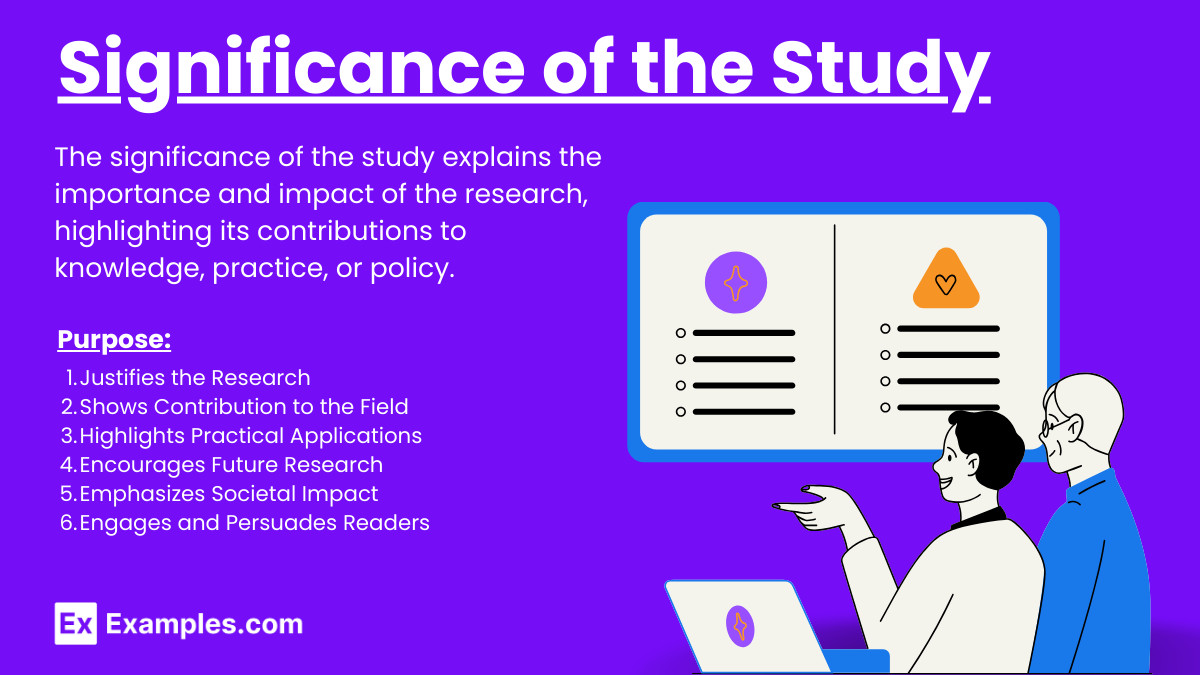
The significance of the study underscores the research’s importance, illustrating its impact on existing knowledge and potential applications. It highlights how the findings address gaps, resolve problems, or contribute to advancements in a specific field. By emphasizing the study’s relevance, it demonstrates the broader implications for society, academia, or industry, justifying the research effort and investment.
What is the Significance of the Study?
The significance of the study illustrates the research’s importance, highlighting its impact on existing knowledge and potential applications. It addresses gaps, resolves problems, or contributes to advancements in a specific field. Emphasizing the study’s relevance, it demonstrates broader implications for society, academia, or industry, justifying the research effort and investment.
Significance of the Study Format
When writing the “Significance of the Study” section in a research paper , follow this format to ensure clarity and impact:
1. Introduction
- Contextual Background: Provide a brief background of the research topic.
- Research Problem: State the problem the study addresses.
2. Purpose of the Study
- Objective Statement: Clearly define the main objective of the study.
- Scope of the Study: Outline what the study covers.
3. Importance to the Field
- Contribution to Knowledge: Explain how the study will add to existing knowledge.
- Theoretical Significance: Discuss the study’s theoretical implications.
4. Practical Implications
- Real-world Application: Describe how the findings can be applied in practical setting .
- Beneficiaries: Identify who will benefit from the research (e.g., policymakers, practitioners, educators).
5. Advancement of Future Research
- Foundation for Future Studies: Indicate how the study can serve as a basis for further research.
- Research Gaps: Highlight any gaps the study aims to fill.
6. Societal Impact
- Broader Implications: Discuss the potential societal benefits or changes resulting from the study.
- Public Awareness: Explain how the study can raise awareness or understanding of the issue.
7. Conclusion
- Summary of Significance: Recap the main points that underline the importance of the study.
- Call to Action: Encourage specific actions or further studies based on the research findings.
Significance of the Study on Impact of Remote Work on Employee Productivity in the Tech Industry 1. Introduction The rapid shift to remote work due to the COVID-19 pandemic has fundamentally changed the dynamics of workplace productivity, especially within the tech industry. This study aims to examine how remote work influences employee productivity compared to traditional office settings. 2. Purpose of the Study The primary objective of this research is to evaluate the productivity levels of tech employees working remotely versus those working in office environments. The study analyzes various productivity metrics, such as task completion rates, quality of work, and employee satisfaction. 3. Importance to the Field This research contributes significantly to the existing body of knowledge by providing empirical data on the productivity impacts of remote work. It refines theoretical models of workplace productivity and offers new insights into remote work dynamics specific to the tech sector. Understanding these dynamics helps scholars and practitioners alike in shaping effective productivity strategies in the evolving work landscape. 4. Practical Implications The findings from this study have crucial practical implications for tech companies aiming to optimize their remote work policies. By understanding how remote work affects productivity, managers and HR departments can develop strategies to enhance employee performance and well-being in remote settings. These insights can also assist in designing training programs that equip employees with the skills needed for effective remote work. 5. Advancement of Future Research This study sets the stage for future research on long-term remote work trends and their impacts across various industries. It addresses existing gaps by providing a detailed analysis of how remote work influences productivity in the tech sector. Future researchers can build on this work to explore remote work dynamics in other fields and under different conditions. 6. Societal Impact The study highlights the broader societal implications of remote work, such as promoting work-life balance, reducing urban congestion, and lowering environmental pollution. By demonstrating the potential benefits of remote work, this research can influence public policy and corporate strategies towards more sustainable and flexible working conditions, ultimately contributing to societal well-being. 7. Conclusion Understanding the impact of remote work on productivity is essential for developing effective work policies and creating healthier work environments. This study provides valuable insights that can guide tech companies in optimizing their remote work strategies. Future research should explore the long-term effects of remote work across different sectors to provide a comprehensive understanding of its benefits and challenges.
Significance of the Study Examples
- Significance of the Study: Research Paper
- Significance of the Study: Qunatitive Research
- Significance of the Study: Qualitative Research
Research Paper
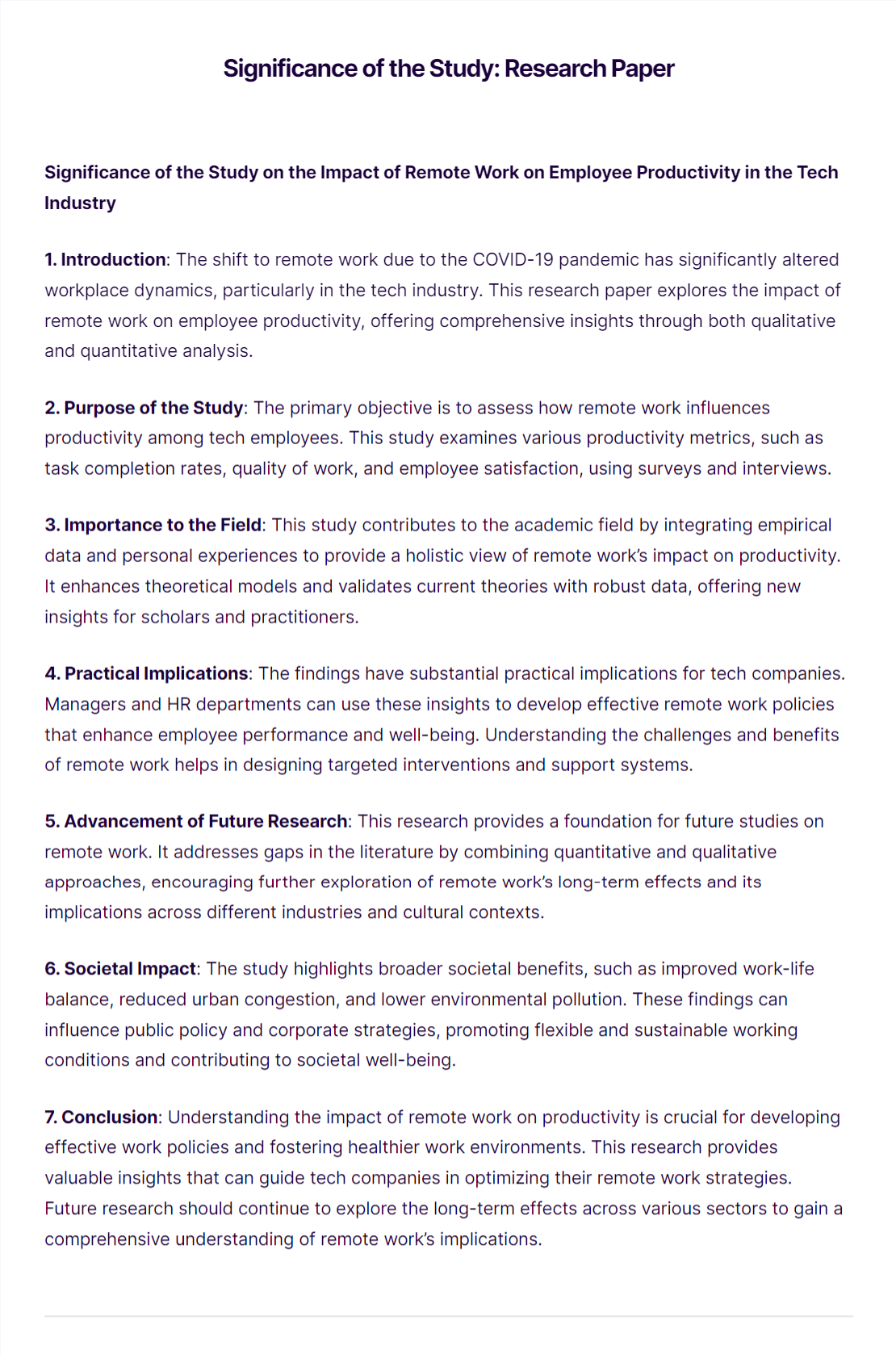
Qunatitive Research
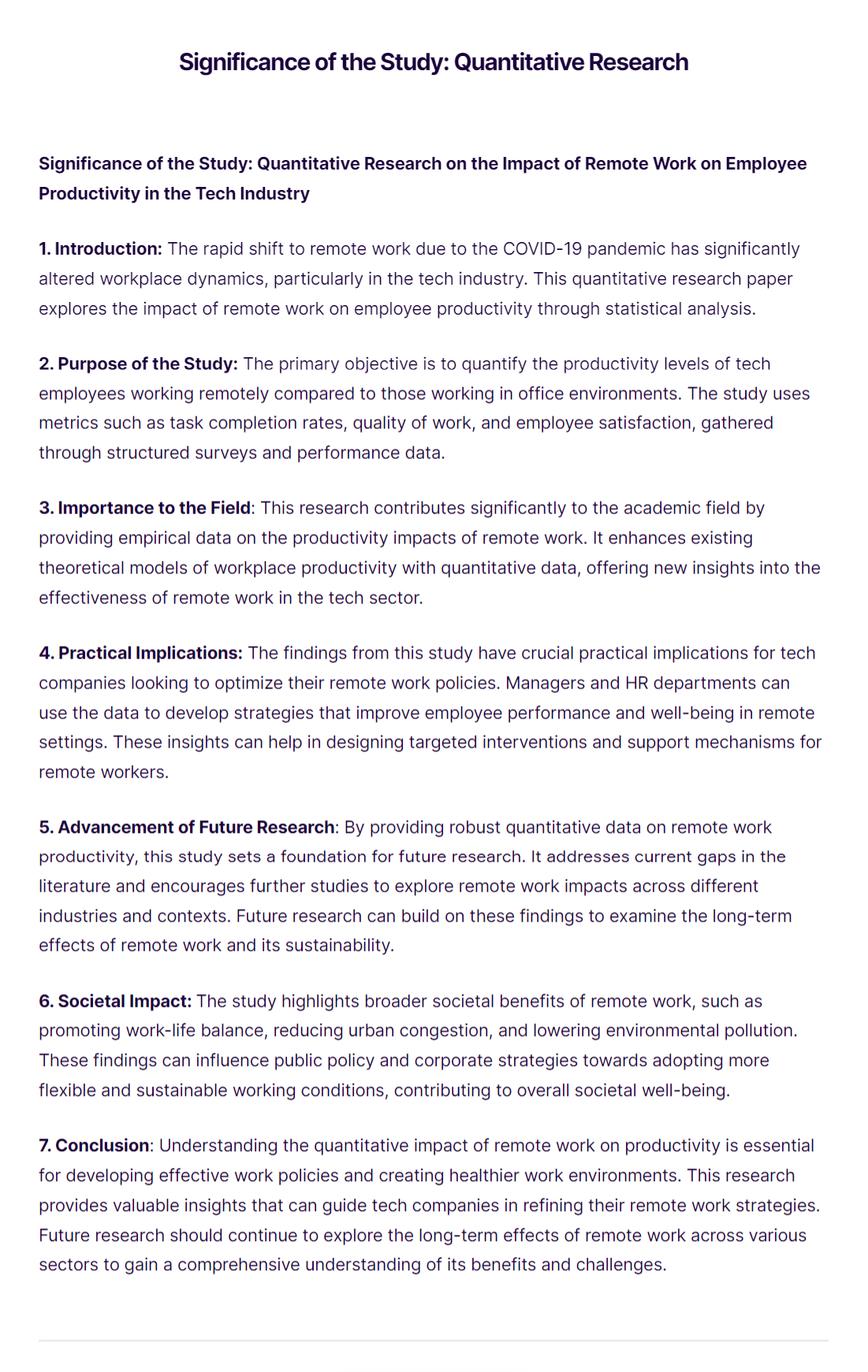
Qualitative Research
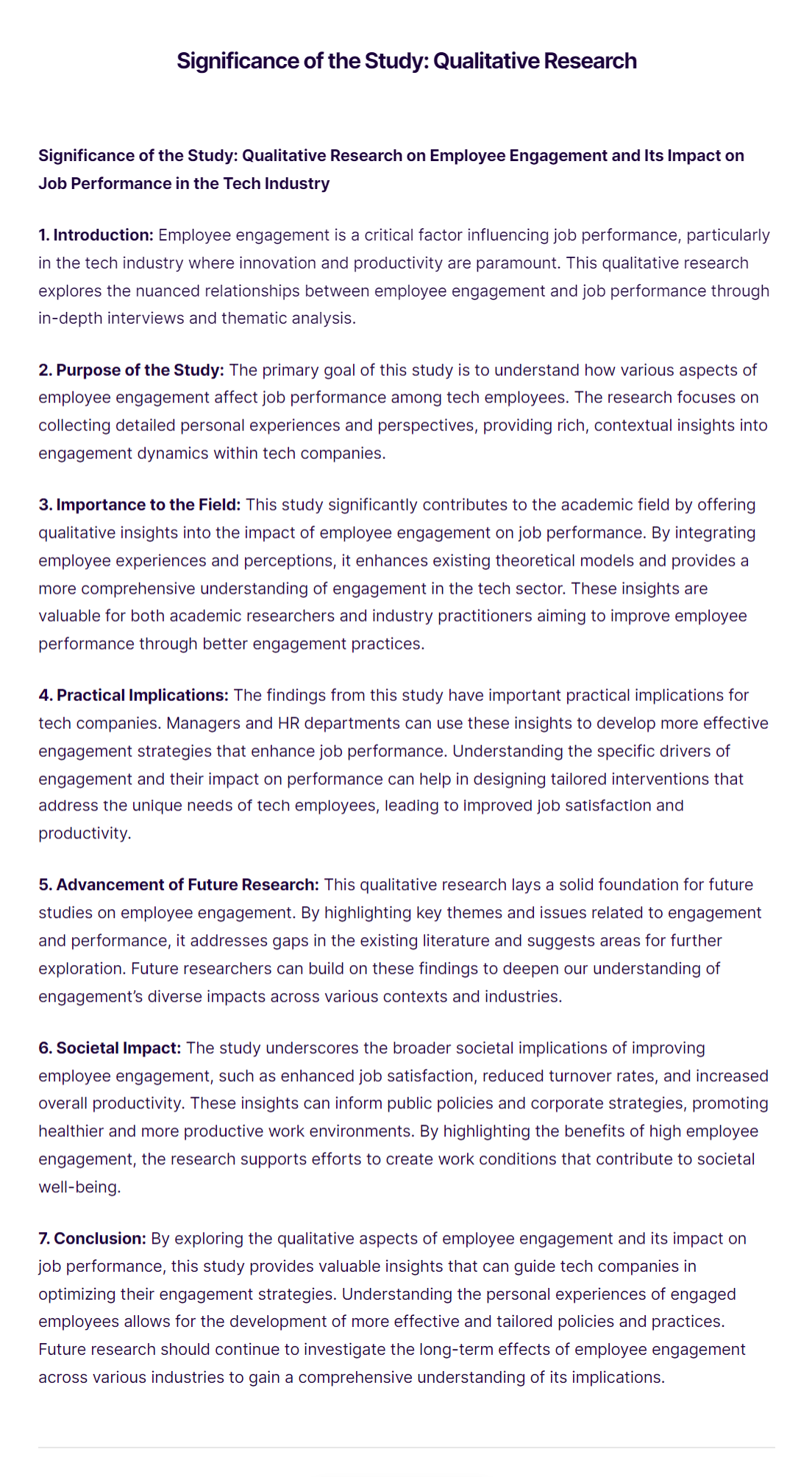
More Significance of the Study Examples
- Educational Resources and Student Performance
- Business Innovation and Competitive Advantage
- Social Media Influencers and Brand Loyalty
- Mental Health Benefits of Physical Activ ity
- Sustainable Food Practices and Consumer Behavior
- Green Building and Energy Efficiency
- Technology in Healthcare
- Employee Engagement and Job Performance
- Business Strategies and Market Adaptation
- Mindfulness at Work
Purpose of Writing the Significance of a Study
When writing academic research or scholarly articles, one critical section is the significance of the study . This part addresses the importance and impact of the research, both theoretically and practically. Here are the main purposes of writing the significance of a study:
1. Establishing Relevance
The primary purpose is to explain why the study is relevant. It connects the research to existing literature, highlighting gaps or deficiencies that the current study aims to fill. This helps to justify the research problem and demonstrates the necessity of the study.
2. Highlighting Contributions
This section outlines the contributions the study will make to the field. It discusses how the findings can advance knowledge, theory, or practice. The significance emphasizes new insights, innovative approaches, or advancements that the study will provide.
3. Guiding Further Research
The significance of the study often includes suggestions for future research. By identifying limitations and unexplored areas, it encourages other researchers to pursue related questions. This helps to build a foundation for continuous inquiry and discovery.
4. Demonstrating Practical Applications
Beyond theoretical contributions, the significance of the study highlights practical applications. It shows how the research can solve real-world problems, improve practices, or influence policy-making. This connects academic research to practical outcomes that benefit society.
5. Engaging Stakeholders
Writing the significance of a study engages various stakeholders, including scholars, practitioners, policymakers, and funders. It communicates the value of the research to different audiences, making it easier to garner support, funding, or collaboration.
6. Enhancing Research Impact
A well-articulated significance section enhances the overall impact of the research. It underscores the importance and potential influence of the study, increasing its visibility and recognition in the academic community and beyond.
Benefits of Significance of the Study
Writing the significance of a study offers several benefits that enhance the research’s value and impact. Here are the key benefits:
1. Clarifies Research Value
The significance section clarifies the value of the research by explaining its importance and relevance. It helps readers understand why the study matters and what contributions it aims to make to the field.
2. Justifies the Research Problem
This section provides a rationale for the study by highlighting the research problem’s importance. It justifies the need for the study by identifying gaps in existing literature and explaining how the research will address these gaps.

3. Engages and Motivates Readers
A well-articulated significance section engages and motivates readers, including scholars, practitioners, and policymakers. It draws their interest by showcasing the study’s potential impact and benefits.
4. Secures Funding and Support
Explaining the significance of the study can help secure funding and support from stakeholders. Funding agencies and institutions are more likely to invest in research that demonstrates clear value and potential impact.
5. Guides Research Focus
The significance section helps guide the research focus by clearly defining the study’s contributions and goals. This clarity ensures that the research stays on track and aligns with its intended purpose.
6. Enhances Academic Credibility
Demonstrating the significance of a study enhances the researcher’s academic credibility. It shows a deep understanding of the field and the ability to identify and address important research questions.
7. Encourages Further Research
By identifying gaps and suggesting future research directions, the significance section encourages other researchers to build on the study’s findings. This fosters a continuous cycle of inquiry and discovery in the field.
8. Highlights Practical Applications
The significance section highlights practical applications of the research, showing how it can solve real-world problems. This makes the study more appealing to practitioners and policymakers who are interested in practical solutions.
9. Increases Research Impact
A clear and compelling significance section increases the overall impact of the research. It enhances the study’s visibility and recognition, leading to broader dissemination and application of the findings.
10. Supports Academic and Professional Goals
For researchers, writing a strong significance section supports academic and professional goals. It can contribute to career advancement, publication opportunities, and recognition within the academic community.
How to Write the Significance of the Study
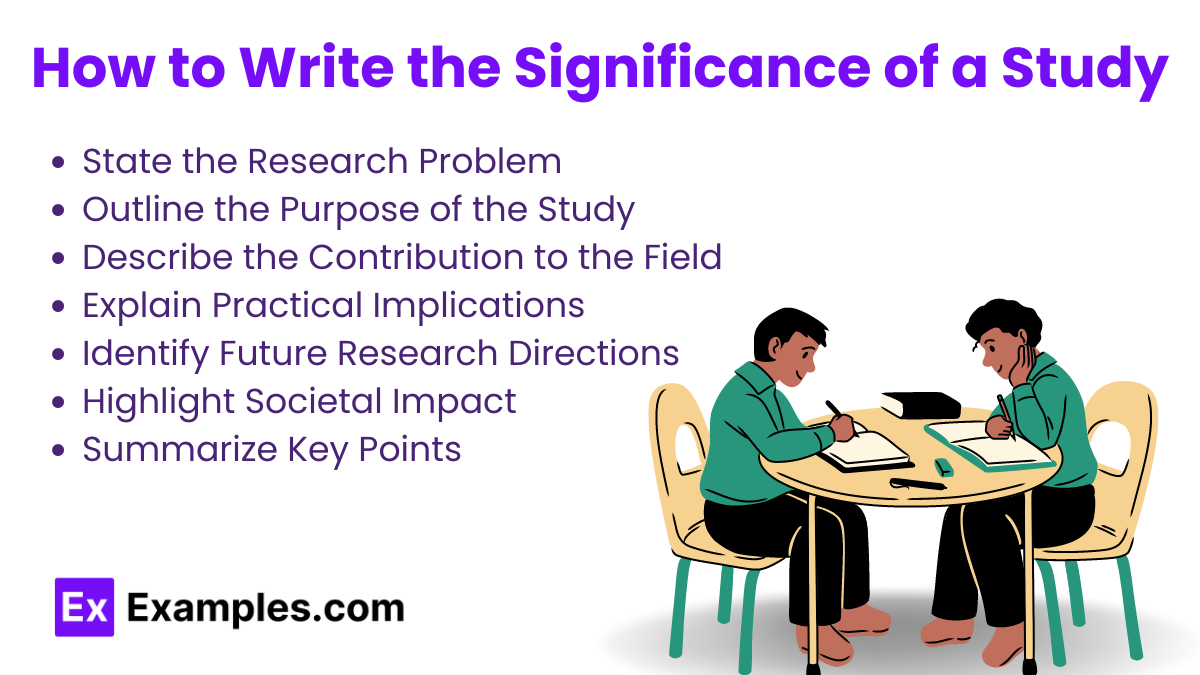
Writing the significance of a study involves explaining the importance and impact of your research. This section should clearly articulate why your study matters, how it contributes to the field, and what practical applications it may have. Here’s a step-by-step guide to help you write an effective significance of the study:
Start with the Context
Begin by providing a brief overview of the research context. This sets the stage for understanding the importance of your study. Example : “In today’s digital age, digital literacy has become a critical skill for students. As technology continues to integrate into education, understanding its impact on academic performance is essential.”
Identify the Research Gap
Explain the gap in existing literature or the problem your study aims to address. Highlighting this gap justifies the need for your research. Example: “Despite the growing importance of digital literacy, there is limited empirical evidence on its direct impact on high school students’ academic performance. This study seeks to fill this gap by investigating this relationship.”
Explain the Theoretical Contributions
Discuss how your study will contribute to existing theories or knowledge in the field. This shows the academic value of your research. Example : “The findings of this study will contribute to educational theory by providing new insights into how digital literacy skills influence student learning outcomes. It will expand the current understanding of the role of technology in education.”
Highlight Practical Implications
Describe the practical applications of your research. Explain how the findings can be used in real-world settings. Example : “Practically, the results of this study can inform educators and policymakers about the importance of incorporating digital literacy programs into the curriculum. It will help design more effective teaching strategies that enhance students’ digital competencies.”
Mention the Beneficiaries
Identify who will benefit from your study. This could include scholars, practitioners, policymakers, or specific groups affected by the research problem. Example: “This research will benefit educators, school administrators, and policymakers by providing evidence-based recommendations for integrating digital literacy into educational practices. Additionally, students will benefit from improved learning outcomes and better preparedness for the digital world.”
Suggest Future Research
Point out areas for future research that stem from your study. This shows the ongoing relevance and potential for further inquiry. Example : “Future research could explore the long-term effects of digital literacy on career readiness and job performance. Additionally, studies could examine the impact of specific digital literacy interventions on diverse student populations.”
Use Clear and Concise Language
Ensure your writing is clear and concise. Avoid jargon and overly complex sentences to make your significance easily understandable.
What is the significance of a study?
The significance explains the importance, contributions, and impact of the research, highlighting why the study is necessary and how it benefits the field and society.
Why is the significance of a study important?
It justifies the research, engages readers, secures funding, guides the research focus, and highlights practical and theoretical contributions, enhancing the study’s impact and visibility.
How do you identify the significance of a study?
Identify gaps in existing literature, potential contributions to theory and practice, and practical applications that address real-world problems, demonstrating the study’s relevance and importance.
What should be included in the significance of a study?
Include the research context, identified gaps, theoretical contributions, practical applications, beneficiaries, and suggestions for future research to comprehensively explain the study’s importance.
How long should the significance of a study be?
Typically, the significance section should be concise, around 1-2 paragraphs, providing enough detail to clearly convey the study’s importance and contributions.
Can the significance of a study influence funding decisions?
Yes, a well-articulated significance section can attract funding by demonstrating the study’s potential impact and relevance to funding agencies and stakeholders.
How does the significance of a study benefit researchers?
It clarifies the research focus, enhances credibility, guides the research process, and supports academic and professional goals by highlighting the study’s contributions and importance.
Should the significance of a study mention future research?
Yes, mentioning future research directions shows the ongoing relevance of the study and encourages further inquiry, contributing to continuous advancement in the field.
How does the significance of a study relate to the research problem?
The significance justifies the research problem by explaining its importance, highlighting gaps in existing knowledge, and showing how the study addresses these issues.
Can practical applications be part of the significance of a study?
Yes, practical applications are crucial, showing how the research can solve real-world problems, influence practices, and benefit specific groups or society overall.
Text prompt
- Instructive
- Professional
10 Examples of Public speaking
20 Examples of Gas lighting

IMAGES